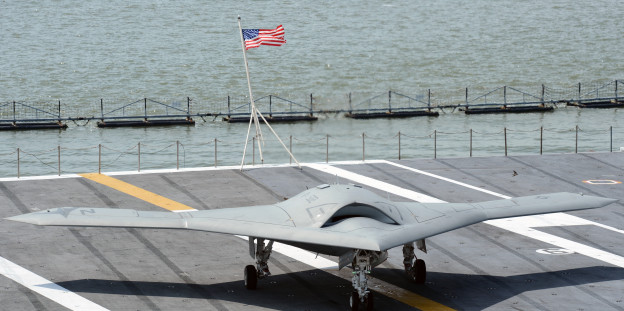
The U.S Navy’s unmanned carrier launched airborne surveillance and strike (UCLASS) program has evolved to call for a jet that is much larger and much more capable than what was envisioned just six months ago, Navy officials told USNI News.
“We’re talking about a 70,000- to 80,000-pound airplane,” Rear Adm. Mike Manazir, the Navy’s director of air warfare said in a 20 December interview. “We’re talking [Grumman F-14] Tomcat size.”
The shift in the character of UCLASS comes as the service prepares to release a set of months-delayed draft requirements to industry, and follows a struggle inside the Pentagon over the character of the aircraft.
“The concepts have moved around. They’ve been: You want unmanned off the carrier to do some off-cycle ISR [intelligence, surveillance, and reconnaissance]—we’re more than that now,” Manazir said. “We have heavy-end ISR and strike capability with some growth in the ability to carry weapons and some growth in the sensor package.”
Lockheed Martin, Boeing, Northrop Grumman and General Atomics are all hoping to secure what looks to one of the Defense Departments few new start development programs for the foreseeable future.
The Navy’s current thinking about the UCLASS concept calls for an aircraft much larger than even the 44,000-lb. Northrop Grumman X-47B unmanned combat air system-demonstrator (UCAS-D).
In fact, the UCLASS could be considerably larger than even the Boeing F/A-18E/F Super Hornet, with some of the proposed UCLASS designs being 68 ft. long—eight feet longer than a Super Hornet, Manazir said.
The UCLASS size and weight numbers suggest that engineers might have to adopt either a twin-engine design or potentially an unaugmented version of the Pratt & Whitney F135 engine, which delivers about 28,000 lbs. of dry thrust, to meet the Navy’s requirements.
“They’re big airplanes, they’re not [General Atomics MQ-1] Predators,” Manazir said. “They’re big, heavy, capable airplanes that will fly for 14 hours, that can give away gas.”
The Navy hopes to use the UCLASS as an aerial refueling tanker to extend the range of the tactical fighter fleet—particularly the Lockheed Martin F-35C Joint Strike Fighter. “We’re going to put a refueling capability into them and they’ll have an endurance package in them,” Manazir said. “They’ll be able to give away something like 20,000 lbs. of gas and still stay up for seven-and-a-half hours.”
The Navy is still looking at what the UCLASS might be able to do for a combat identification role inside contested airspace—which is the mission the Navy currently envisions for it future F-35C fleet.
“If you take that UCLASS and you send it downrange, is it the sensor that gets the combat ID?” Manazir said. “I think with the designs that we’re moving toward to … [we’re] going to have an unmanned airframe that can operate in a non-permissive environment.”
But Manazir cautioned that the UCLASS will not be nearly as stealthy as the F-35C.
“We’re not going have JSF-like stealth,” Manazir said. “You’re not going to have somebody that can go right over the top—you know—of the threat capital city, but you’re going to have something that can stand in somewhat.”
Alternatively, the UCLASS might be useful as a flying missile magazine to supplement the firepower of the F/A-18 and F-35C in air-to-air combat as a robotic wingman of sorts.
“Maybe we put a whole bunch of AMRAAMs (Advanced Medium-Range Air-to-Air Missile) on it and that thing is the truck,” Manazir said. “So this unmanned truck goes downtown with—as far as it can go—with a decision-maker.”
In those situations, Manazir said, a Northrop Grumman E-2D Hawkeye or a F-35C flight leader might command the UCLASS.
But the concepts for what missions the Navy might offload from manned aircraft to the UCLASS are still evolving.
Manazir said that by 2030, once the Navy has some operational experience with the UCLASS, it will have a better institutional understanding of what unmanned aircraft bring to the carrier air wing.
The change in the focus in the UCLASS program described by Manazir is a marked shift from stances the Office of Secretary of Defense (OSD) took on the program earlier this year.
The nature of the program shifted from a high-end system based on a 2006 concept to a lower end system designed to be inexpensive and allow the U.S. to have a system to conduct counter terrorism missions from aircraft carriers.




